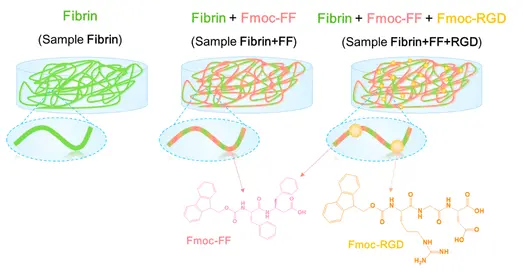
Fibrin Hydrogels are a widely used material in regenerative medicine, often made with fibrinogen obtained from human plasma. However, this process can be very costly and have problems when used in other applications due to their limited mechanical properties. Researchers were interested in the prospect of composite hydrogels, made from the self-assembly of fibrinogen together with Fmoc-FF and Fmoc-RGD. Their results saw that these hydrogels co-assembled from short peptides and fibrin display biocompatibility, as well as the enhanced mechanical properties they were looking for.
Fibrin hydrogel enhanced with short peptide co-assembly
LifeTein provided the group with the essential peptides, Fmoc-FF and Fmoc-RGD, where the team tested different ratios of these peptides in combination with the fibrin precursor. Even from the naked eye alone, they could immediately tell the difference when the peptides were added in the presence of CaCl2. The resulting mixture displayed very favorable and biocompatible characteristics, even similar to the fibrin hydrogels it was replicating. The mixture could even jellify in situ, potentially allowing the pregel to be administered via injection
The protocol the group explored holds great potential for the future of regenerative medicine. Not only do they not cause any inflammatory response, but the possibilities still exist to modify these fibrin hydrogels for even further medicinal usage. The Fmoc-FF and Fmoc-RGD peptides used for the co-assembly of this hydrogel are commercially available, and companies like LifeTein are always ready to supply vital peptides like these to any groups researching to better our future.
Cristina Gila-Vilchez, Mari Carmen Mañas-Torres, Óscar Darío García-García, Alfredo Escribano-Huesca, Laura Rodríguez-Arco, Víctor Carriel, Ismael Rodriguez, Miguel Alaminos, Modesto Torcuato Lopez-Lopez, and Luis Álvarez de Cienfuegos
ACS Applied Polymer Materials 2023 5 (3), 2154-2165
DOI: 10.1021/acsapm.2c02164